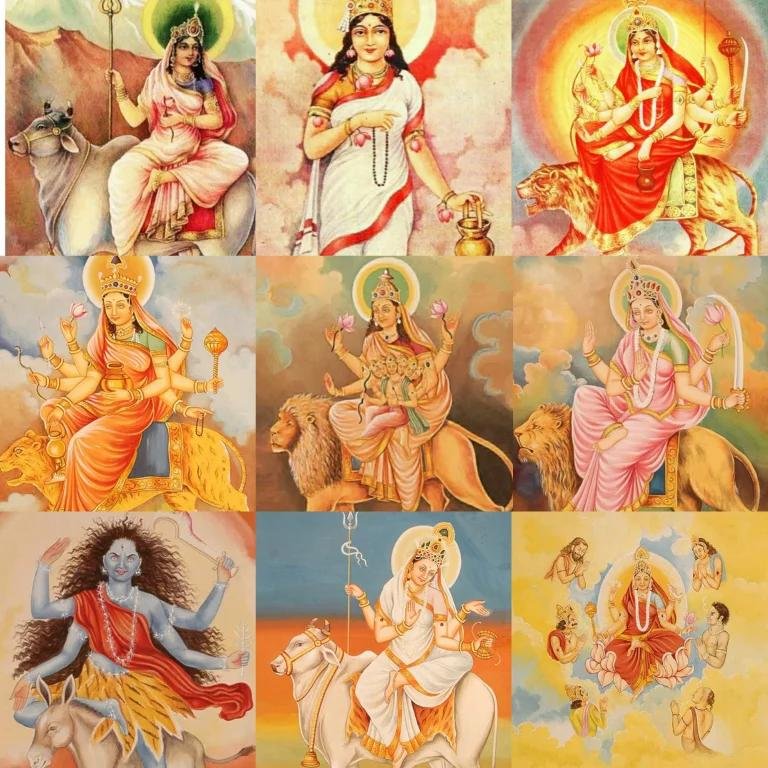Navratri: Celebrating the Nine Forms of Devi Durga
Navratri: The Nine Avatars of Goddess Durga

Navratri, one of the most celebrated Hindu festivals, spans over nine nights and is dedicated to worshipping the nine different avatars (forms) of Goddess Durga. Each form symbolizes a unique attribute of the goddess and represents a different aspect of life and spirituality. The festival signifies the triumph of good over evil, as it commemorates the victory of Goddess Durga over the buffalo demon Mahishasura.
History Behind Navratri
The origin of Navratri is rooted in ancient Hindu scriptures, particularly the Devi Mahatmya, which narrates the story of the goddess battling the evil forces. The festival marks the victory of light over darkness, reminding devotees of the power of good and the importance of perseverance, courage, and devotion.
Purpose of Navratri
The primary purpose of Navratri is to honor and invoke the energy and blessings of Goddess Durga in her various forms. It is a time of devotion, spiritual reflection, and rejuvenation, where devotees seek to purify themselves, overcome negativity, and receive the goddess’s blessings for health, wealth, and prosperity.
The Nine Avatars of Durga:

- Shailaputri (Daughter of the Mountains)
- Day 1: The first form of Durga, Shailaputri, symbolizes purity and strength. She is the daughter of the Himalayas and represents stability and a strong foundation.
- Brahmacharini (The Ascetic)
- Day 2: This avatar represents penance, devotion, and discipline. Brahmacharini signifies the pursuit of knowledge, wisdom, and the importance of dedication in one’s spiritual journey.
- Chandraghanta (The Warrior Goddess)
- Day 3: Chandraghanta, with a crescent moon on her forehead, embodies courage, bravery, and fearlessness. She is a fierce form of Durga, symbolizing the power to fight against evil forces.
- Kushmanda (The Cosmic Creator)
- Day 4: Kushmanda is believed to have created the universe with her divine smile. She symbolizes energy, vitality, and creativity, encouraging devotees to seek positive energy and creativity in their lives.
- Skandamata (Mother of Skanda)
- Day 5: Skandamata is the mother of Lord Kartikeya (Skanda). This form represents maternal love, nurturing, and care, providing devotees with the strength to protect and support their loved ones.
- Katyayani (The Warrior Goddess)
- Day 6: Katyayani, born to destroy the demon Mahishasura, embodies courage, power, and determination. Devotees worship her for strength, protection, and success, particularly in love and relationships.
- Kalaratri (The Dark Night)
- Day 7: Kalaratri, the fiercest form of Durga, signifies the destruction of darkness and ignorance. She is worshipped to remove negativity, fear, and evil, bringing peace and prosperity.
- Mahagauri (The Goddess of Purity)
- Day 8: Mahagauri symbolizes purity, peace, and tranquility. She is worshipped for cleansing one’s sins and for bringing purity and serenity into devotees' lives.
- Siddhidatri (The Granter of Boons)
- Day 9: Siddhidatri is the goddess of wisdom, supernatural powers, and perfection. She bestows knowledge, success, and spiritual enlightenment, guiding devotees to a state of ultimate bliss and fulfillment.
Conclusion
Navratri is a celebration of divine power and spiritual growth. Each form of Goddess Durga teaches us lessons about strength, purity, courage, and devotion. As devotees worship these nine avatars, they aim to conquer their fears, remove negativity, and invite positive energy and divine blessings into their lives.
